Catalogue Entry
Citation
Chicago:
Asher Ethan Miller, “Théodore Géricault, The Oath of Brutus after the Death of Lucretia, ca. 1815–16,” catalogue entry in French Paintings and Pastels, 1600–1945: The Collections of The Nelson-Atkins Museum of Art, ed. Aimee Marcereau DeGalan (Kansas City: The Nelson-Atkins Museum of Art, 2024), https://doi.org/10.37764/78973.5.410.5407.
MLA:
Miller, Asher Ethan. “Théodore Géricault, The Oath of Brutus after the Death of Lucretia, ca. 1815–16,” catalogue entry. French Paintings and Pastels, 1600–1945: The Collections of The Nelson-Atkins Museum of Art, edited by Aimee Marcereau DeGalan, Nelson-Atkins Museum of Art, 2024. doi: 10.37764/78973.5.410.5407.
Théodore Géricault’s legacy as the quintessential French Romantic artist rests primarily on the modern subjects by which he was known to the public during his lifetime. These are the three large paintings he exhibited at the SalonSalon, the: Exhibitions organized by the French Royal Academy of Painting and Sculpture (Académie Royale de Peinture et de Sculpture) and its successor the Academy of Fine Arts (Académie des Beaux Arts), which took place in Paris from 1667 onward.: Charging Chasseur (1812), Wounded Cuirassier (1814), and The Raft of the Medusa (1819), all now in the Musée du Louvre, Paris, as well as a substantial body of published lithographs.1Charging Chasseur was shown again with Wounded Cuirassier in 1814. Another painting exhibited that year, Gunnery Charge in the Plain of Grenelle, is untraced. Secondarily, there are the contents of the artist’s studio, which came to light after he died, in his estate sale.2Tableaux, esquisses, dessins, études diverses, estampes, livres à figures, etc., appartenant à la succession de feu Géricault, peintre d’histoire, Hôtel Bullion, Paris, November 2–3, 1824. Géricault also sold or gave away a small number of works during his lifetime; see Lorenz Eitner, Géricault, His Life and Work (London: Orbis, 1983), 281. This latter group comprises thousands of drawings and oil studies related to myriad unrealized projects, among them works like The Oath of Brutus after the Death of Lucretia, which testifies to Géricault’s engagement with the art and literature of antiquity. In addition to his penchant for subjects drawn from contemporary life and current events, he was, after all, steeped in the Neoclassical aesthetic of his time.
The subject of this boldly painted sketch is a momentous episode of early Roman history that took place in 509 BCE, as recounted by the Roman historian Livy. Lucretia, wife of the nobleman Collatinus, was blackmailed into submitting to the sexual advances of Sextus Tarquinius, son of King Tarquinius Superbus. After Lucretia committed suicide to protect her honor, her widower’s comrade Brutus swore an oath to avenge her death, which he fulfilled by forcing the Tarquin rulers into exile. This event ended monarchical rule in Rome and led to the establishment of the Republic, for which Brutus and Collatinus served as first consuls.3Livy, with an English translation by B. O. Foster (1919; repr. Cambridge, MA: Harvard University Press, 1967), 204–05 (book 1, chapter 59, verses 1–2). In the painting, the lifeless body of Lucretia is supported by Collatinus, who kisses her farewell. Brutus, wearing a red mantle over a blue tunic, stands at the center of the picture. He holds Lucretia’s dagger above his head as a chorus of men raise their arms to join him in a pledge to vindicate the tragic heroine.
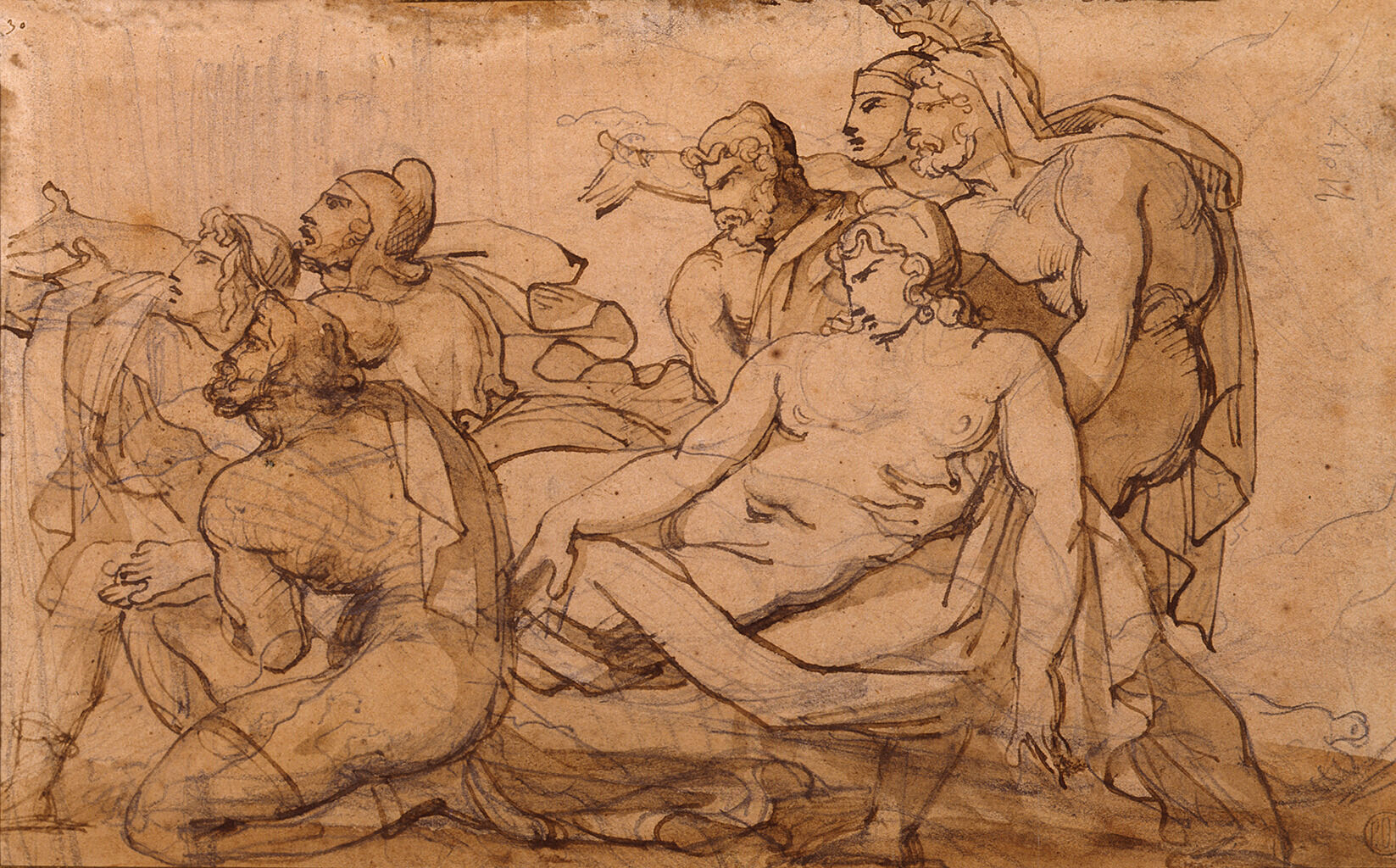
Prior to his departure for Rome, Géricault frequented the studio of his former teacher, the leading history painter Pierre Narcisse Guérin (1774–1833), a strong advocate of the painted sketch as a vehicle for exploring composition.7Guérin’s pupils were prominent among the successful competitors in the concours d’esquisses established by the Academy in 1816. See John Paul Lambertson III, “The Genesis of French Romanticism: P.-N. Guérin’s Studio and the Public Sphere” (PhD diss., University of Illinois at Urbana-Champaign, 1994), 40–42; Grunchec, La peinture à l’École des Beaux-Arts, esp. 1:46 and 2:12, 83; and Mehdi Korchane, Pierre Guérin, 1774–1833 (Paris: Mare et Martin, 2018), esp. 236–38. The Oath of Brutus exemplifies its potential as envisioned by Guérin. The architectural setting is not an illusionistic space derived from a rational system of perspective. Instead, it is highly artificial, enhancing the controlled chaos of the action unfolding among the protagonists, who are enmeshed in a shallow, stage-like space immediately behind the picture planepicture plane: The two-dimensional surface where the artist applies paint.. A veritable pinwheel of bodies and limbs, with Brutus’s clenched fist as its visual fulcrum, unifies the crowded scene enacted here.
The brushwork is quick and summary. Géricault did not apply finishing touches. He constructed the figures intuitively and with breathtaking spontaneity, but not without attention to detail, as revealed by a close examination of Lucretia, Collatinus, and the partial figure immediately to the viewer’s left, who helps to support Lucretia’s body. Here one can see that Géricault began the sketch with a sepia imprimaturaimprimatura: A thin layer of paint applied over the ground layer to establish an overall tonality. layer, which endows the picture with a warm tone overall. He then produced an underdrawingunderdrawing: A drawn or painted sketch beneath the paint layer. The underdrawing can be made from dry materials, such as graphite or charcoal, or wet materials, such as ink or paint., defining contours with the point of a very fine brush dipped in dark brown or possibly black paint. In some places, for example in Collatinus’s white robes, the underdrawing shows through the subsequently applied paint layer. In other places, as in Collatinus’s head and his companion’s profile, the drawing has evidently been applied on top of or adjacent to touches of colored paint to reinforce a contour or detail.
Géricault worked with impressive facility, quickly alternating between line and color and leaving areas of imprimatura in reserve. The result is dazzling rather than purely descriptive. Especially remarkable in this regard is Lucretia, whose glowing, bloodstained white garment clings to her left breast, while her exposed right breast consists of unpainted, essentially negative space defined by the tinted arm of the supporting figure behind her. The eye must navigate the facturefacture: The artist’s characteristic handling of paint. in order to make sense of the image, obliging the viewer to reckon with the artist’s material process. (That is, if Géricault had the viewer in mind as he worked.) Another extraordinary detail is the way Lucretia’s head is tilted back, revealing a neck and chin too dark to be decipherable without the surrounding elements for context; her face is essentially obliterated from view at this angle, hidden in shadow beneath and behind her husband, who bends down to kiss her tenderly.
The theme of the Nelson-Atkins sketch had been popular from the 1760s onward. Artists such as Gavin Hamilton (Scottish, 1723–98) produced works like Oath of Brutus (1763; Yale Center for British Art, New Haven), which in turn inspired the indelible Oath of the Horatii (1784; Musée du Louvre, Paris) by Jacques Louis David (1748–1825), clearly a model for Géricault’s The Oath of Brutus.8See Robert Rosenblum, “Gavin Hamilton’s ‘Brutus’ and Its Aftermath,” Burlington Magazine 103 (January 1961): 8–16. Two drawings by Géricault that preceded the oil sketch, different in character from it and from one another, shed light on the artist’s nonlinear creative process.
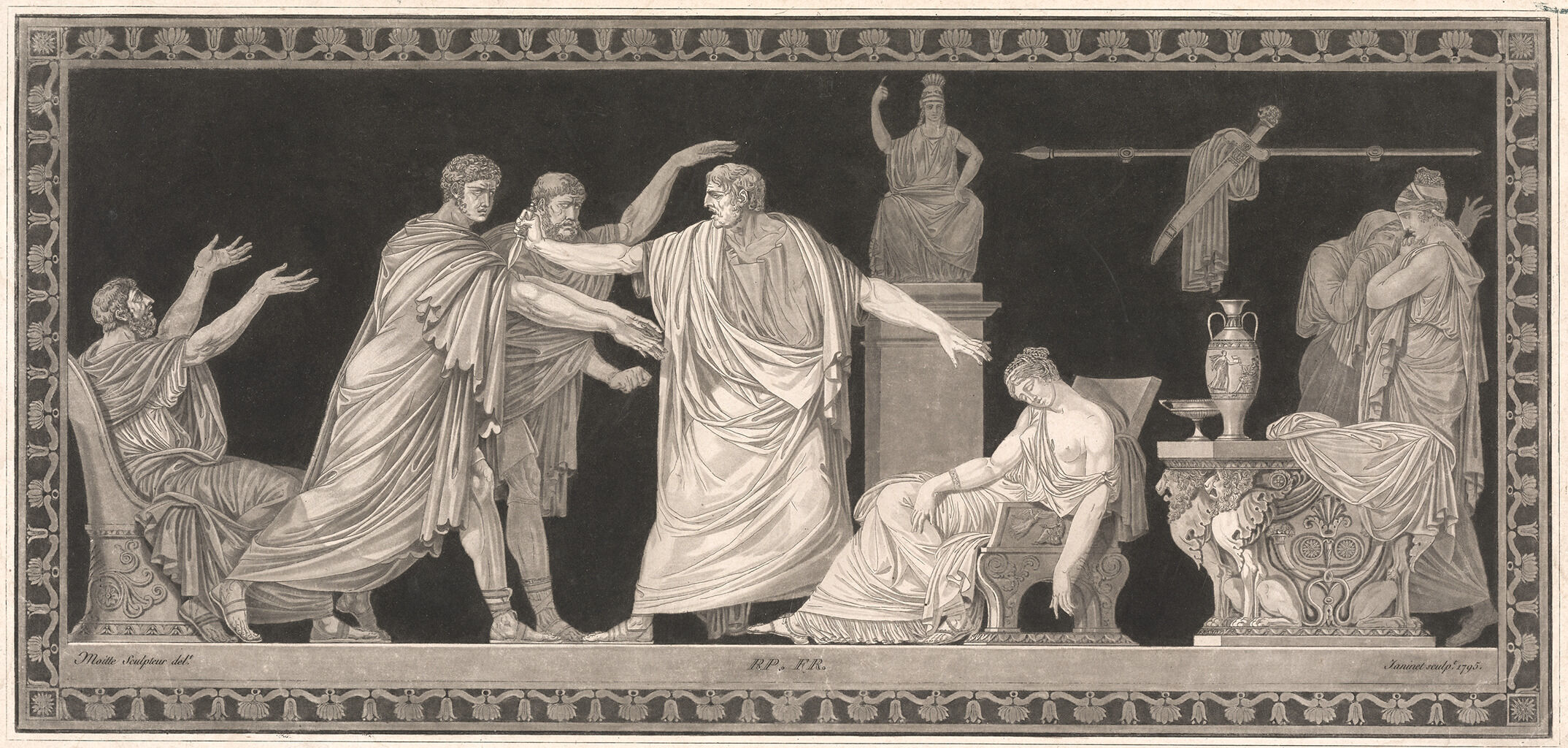 Fig. 2. Jean François Janinet (1752–1814), after Jean Guillaume Moitte, The Death of Lucretia, 1795, engraving, etching, and aquatint on paper, image: 9 5/8 x 20 7/16 in. (24.4 x 51.9 cm), sheet: 10 15/16 x 21 3/4 in. (27.8 x 55.2 cm), Yale University Art Gallery, New Haven, Everett V. Meeks, B.A. 1901, Fund, 2006.109.1. © Art Resource, NY
Fig. 2. Jean François Janinet (1752–1814), after Jean Guillaume Moitte, The Death of Lucretia, 1795, engraving, etching, and aquatint on paper, image: 9 5/8 x 20 7/16 in. (24.4 x 51.9 cm), sheet: 10 15/16 x 21 3/4 in. (27.8 x 55.2 cm), Yale University Art Gallery, New Haven, Everett V. Meeks, B.A. 1901, Fund, 2006.109.1. © Art Resource, NY
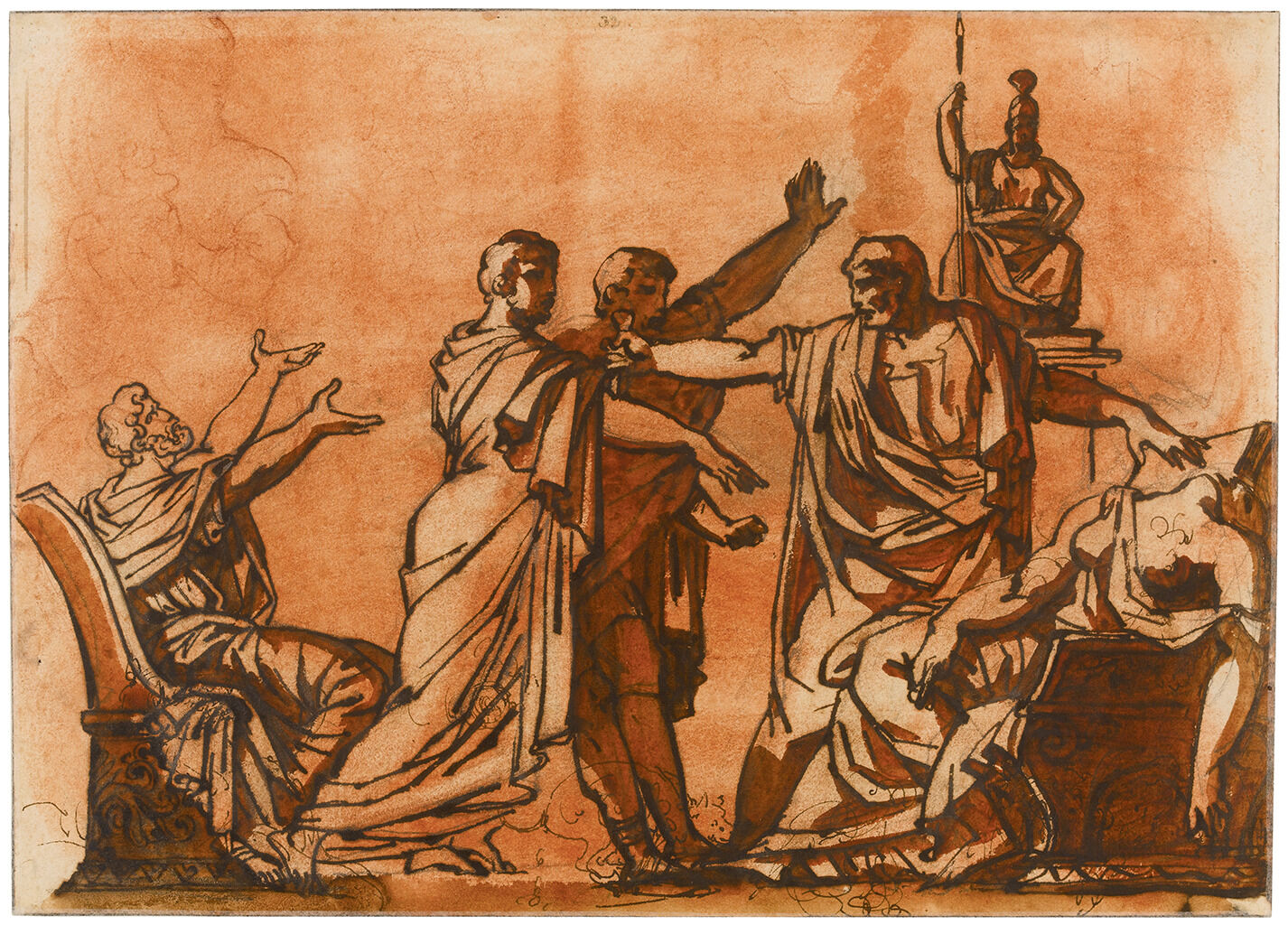 Fig. 3. Théodore Géricault, The Death of Lucretia, after Moitte, ca. 1815–16, pen and brown ink over black and red chalk on prepared paper, 11 x 7 7/8 in. (19.9 x 27.8 cm), private collection, reproduced in Old Master Drawings, Sotheby’s, New York, January 28, 2015, no. 165.
Fig. 3. Théodore Géricault, The Death of Lucretia, after Moitte, ca. 1815–16, pen and brown ink over black and red chalk on prepared paper, 11 x 7 7/8 in. (19.9 x 27.8 cm), private collection, reproduced in Old Master Drawings, Sotheby’s, New York, January 28, 2015, no. 165.
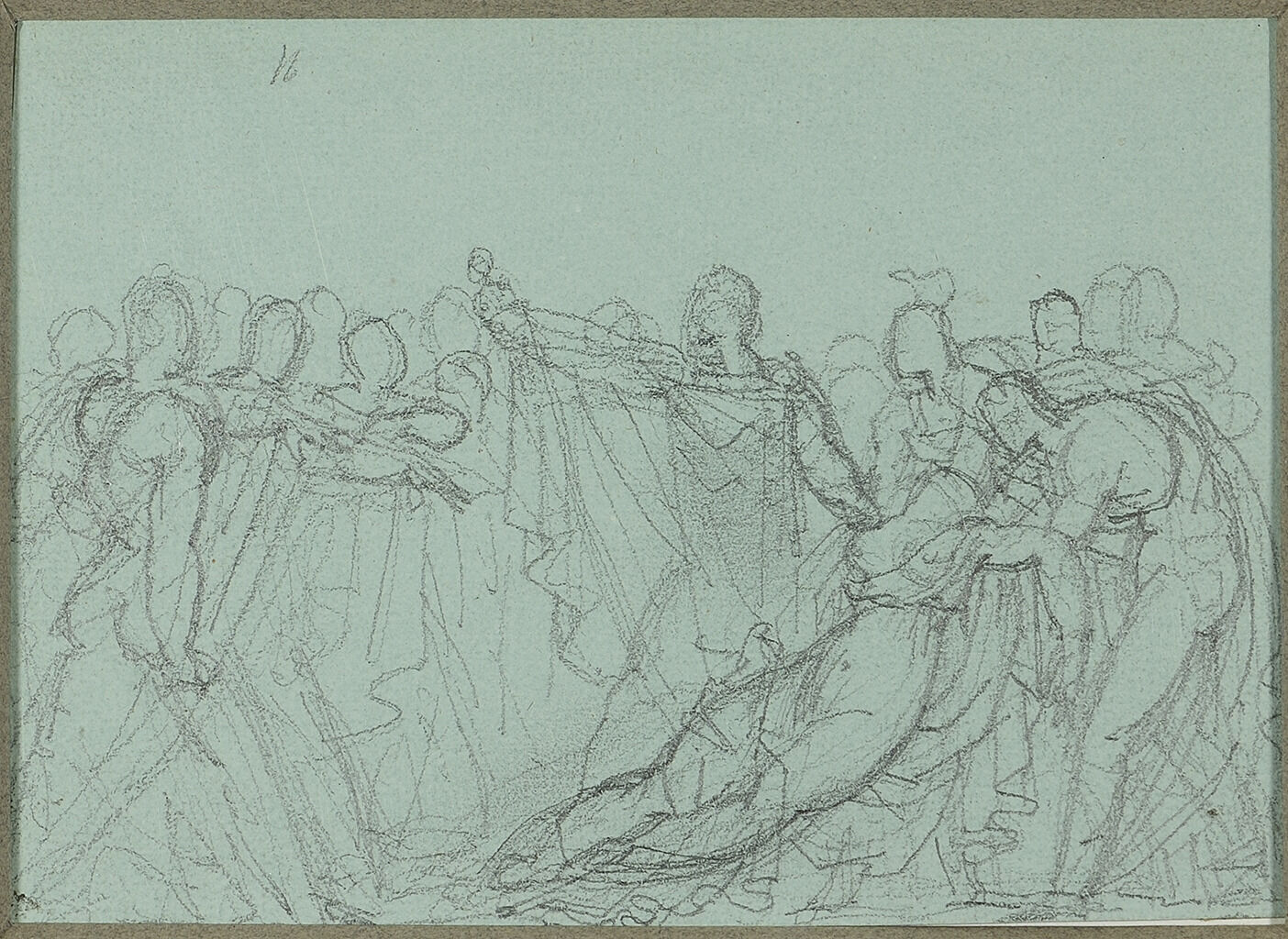
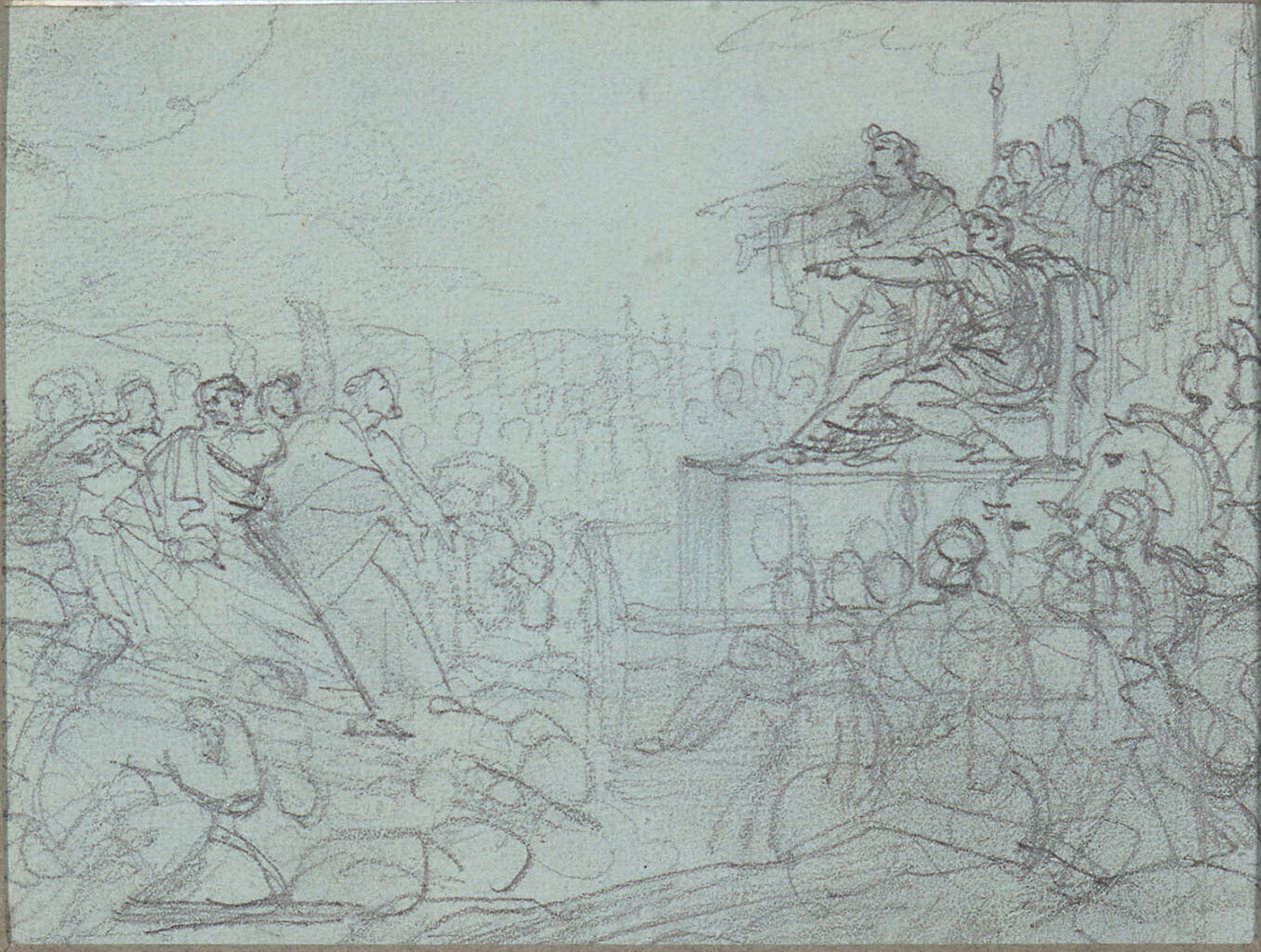
If the three Lucretia and Brutus studies were by an artist other than Géricault, such considerable variations in medium, technique, and style might suggest that they were conceived under unrelated circumstances and do not belong to a single creative continuum. Yet the existence of three disparate works treating the same subject from the same brief span of time is symptomatic of Géricault’s intensely ruminative approach to a single theme. The formal differences between them may be said to reflect Guérin’s observation that Géricault “has in him the stuff of three or four painters.”12“Il a en lui l’étoffe de trois ou quatre peintres.” According to Géricault’s follower Antoine-Alphonse Montfort (1802–84), as quoted by the artist Louis-Pierre Henriquel, called Henriquel-Dupont (1797–1892); see Yveline Cantarel-Besson, “Le Manuscrit de Montfort,” in Laveissière and Michel, eds., Géricault, 311. But to understand the relationship of the drawings to the oil painting requires further consideration of the shifts that Géricault imposed on Brutus.
In the oil, Brutus remains at the center. Unlike the preceding drawings, however, in which his body is shown turned to the left, it now faces emphatically to the right, in strict profile. The foremost figures on the left side of the composition have been reduced in number to two: the elderly bearded man who reacts to Lucretia’s death and the clean-shaven soldier behind him, who looks up at Brutus’s dagger. On the right side of the composition, the group consisting of Lucretia’s bearers and mourners has now been augmented by oath-takers arrayed behind them.
It is not easy to follow the reversals of Brutus’s position as they culminate in the oil sketch, but they are significant. Reversals of composition played a crucial role in Géricault’s creative process. Throughout his career, encompassing Charging Chasseur and The Raft of the Medusa but also including the aborted Oenone and Paris project, Géricault investigated multiple pictorial solutions to a theme before he arrived at the stage when he reversed the composition so that the action depicted unfolds from left to right, maximizing the dramatic effect.13See Lorenz Eitner, “Reversals of Direction in Géricault’s Compositional Projects,” in Stil und Überlieferung in der Kunst des Abendlandes: Akten des 21. Internationalen Kongresses für Kunstgeschichte in Bonn 1964 (Berlin: Gebr. Mann, 1967), 3:126–33, plates 3/20–24.
There may be other studies by Géricault relating to the Lucretia and Brutus campaign that have not yet come to light; no finished work on the theme seems to have been painted. Yet an epilogue of sorts exists in a work by the 1816 Prix de Rome laureate in the category of history painting, Antoine-Jean-Baptiste Thomas (1791–1834), whom Géricault knew in Italy in 1816–17, if not before. In Rome, in 1818, Thomas made an accomplished wash and gouache drawing reprising the theme of Lucretia and Brutus, which invites speculation about a direct connection between them.14The Oath of Brutus, pen and brown wash heightened with white over pencil on buff wove paper, 10 5/16 x 13 5/8 in. (26.2 x 34.6 cm); signed, dated, and inscribed (lower right): Thomas Rome 1818; Cantor Center for Visual Arts, Stanford University, 1975.45. Thomas was a pupil of François André Vincent (1746–1816). On Géricault and Thomas, see Wheelock Whitney, Géricault in Italy (New Haven: Yale University Press, 1997), passim.
Notes:
-
Charging Chasseur was shown again with Wounded Cuirassier in 1814. Another painting exhibited that year, Gunnery Charge in the Plain of Grenelle, is untraced.
-
Tableaux, esquisses, dessins, études diverses, estampes, livres à figures, etc., appartenant à la succession de feu Géricault, peintre d’histoire, Hôtel Bullion, Paris, November 2–3, 1824. Géricault also sold or gave away a small number of works during his lifetime; see Lorenz Eitner, Géricault, His Life and Work (London: Orbis, 1983), 281.
-
Livy, with an English translation by B. O. Foster (1919; repr. Cambridge, MA: Harvard University Press, 1967), 204–05 (book 1, chapter 59, verses 1–2).
-
See Eitner, Géricault, 84.
-
The Prix de Rome funded an extended stay in Rome. For well-documented summaries of Géricault’s attempts to secure the prize in 1812 and 1816, see Bruno Chenique in Sylvain Laveissière and Régis Michel, eds., Géricault, exh. cat. (Paris: Réunion des musées nationaux, 1991), 267–68, 275.
-
On the drawing illustrated here as Fig. 1 (former collection Hans E. Bühler, Winterthur, Switzerland), see Théodore Géricault: The Hans E. Bühler Collection of Pictures, Drawings and Lithographs, Christie’s, London, November 15, 1985, lot 47, recto; and on the theme of Oenone and the dying Paris, see esp. Eitner, Géricault, 87ff.; and Philippe Grunchec, Master Drawings by Géricault, exh. cat. (Washington, DC: International Exhibitions Foundation, 1985), 58–65, cat. nos. 17–20. The most comprehensive account of the 1816 Prix de Rome competition is found in Philippe Grunchec, La peinture à l’École des Beaux-Arts: Les concours des Prix de Rome, 1797–1863, exh. cat. (Paris: École nationale supérieure des Beaux-Arts, 1986), 1:106–07; 2:58–60, 275, 312–13.
-
Guérin’s pupils were prominent among the successful competitors in the concours d’esquisses established by the Academy in 1816. See John Paul Lambertson III, “The Genesis of French Romanticism: P.-N. Guérin’s Studio and the Public Sphere” (PhD diss., University of Illinois at Urbana-Champaign, 1994), 40–42; Grunchec, La peinture à l’École des Beaux-Arts, esp. 1:46 and 2:12, 83; and Mehdi Korchane, Pierre Guérin, 1774–1833 (Paris: Mare et Martin, 2018), esp. 236–38.
-
See Robert Rosenblum, “Gavin Hamilton’s ‘Brutus’ and Its Aftermath,” Burlington Magazine 103 (January 1961): 8–16.
-
See Old Master Drawings, Sotheby’s, New York, January 28, 2015, lot 165. On the reverse of the same sheet is another drawing, The Water Carrier, pen and brown ink over black and red chalk and watercolor.
-
See, for example, Man Rescuing a Woman from a Flood (Musée des Beaux-Arts, Angers, inv. MTC 4854) and two versions of Satyr and Nymph (for the first, see Grunchec, Master Drawings by Géricault, 63, 65, cat. no. 20, recto, in a private collection; for the second, see Dessins anciens et modernes, Drouot-Richelieu, Paris, December 1, 2008, lot 155).
-
The drawings by Géricault illustrated here as Figs. 4 and 5 come from the so-called Album Blanche; they were sold together in a single lot at Drouot-Montaigne, Paris, March 17, 1989, lot 3, as Scène de guerre romaine and Virginius tuant sa fille. There are two versions of Lethière’s Brutus Condemning His Sons to Death. The first, measuring 23 3/8 x 39 in. (59.4 x 99.1 cm), was painted in 1788 and exhibited at the Salons of 1795 and 1801 (Clark Art Institute, Williamstown, MA, 2018.1.1). The second, measuring 17 5/16 x 30 13/16 in. (44 x 78.3 cm), was painted in 1811 and exhibited at the Salon of 1812 (Musée du Louvre, Paris, INV 6228). The latter was exhibited at the Egyptian Hall, London, in 1816, which would influence Géricault’s own decision to exhibit The Raft of the Medusa there in 1820; Lethière’s son, Auguste, assisted Géricault with the shipping (Lorenz Eitner to Ann Guite of Richard L. Feigen and Co., August 7, 1994, NAMA curatorial files.)
-
“Il a en lui l’étoffe de trois ou quatre peintres.” According to Géricault’s follower Antoine-Alphonse Montfort (1802–84), as quoted by the artist Louis-Pierre Henriquel, called Henriquel-Dupont (1797–1892); see Yveline Cantarel-Besson, “Le Manuscrit de Montfort,” in Laveissière and Michel, eds., Géricault, 311.
-
See Lorenz Eitner, “Reversals of Direction in Géricault’s Compositional Projects,” in Stil und Überlieferung in der Kunst des Abendlandes: Akten des 21. Internationalen Kongresses für Kunstgeschichte in Bonn 1964 (Berlin: Gebr. Mann, 1967), 3:126–33, plates 3/20–24.
-
The Oath of Brutus, pen and brown wash heightened with white over pencil on buff wove paper, 10 5/16 x 13 5/8 in. (26.2 x 34.6 cm); signed, dated, and inscribed (lower right): Thomas Rome 1818; Cantor Center for Visual Arts, Stanford University, 1975.45. Thomas was a pupil of François André Vincent (1746–1816). On Géricault and Thomas, see Wheelock Whitney, Géricault in Italy (New Haven: Yale University Press, 1997), passim.
Technical Entry
Technical entry forthcoming.
Documentation
Citation
Chicago:
Glynnis Napier Stevenson, “Théodore Géricault, The Oath of Brutus after the Death of Lucretia, ca. 1815–16,” documentation in French Paintings and Pastels, 1600–1945: The Collections of The Nelson-Atkins Museum of Art, ed. Aimee Marcereau DeGalan (Kansas City: The Nelson-Atkins Museum of Art, 2024), https://doi.org/10.37764/78973.5.410.4403.
MLA:
Stevenson, Glynnisn Napier. “Théodore Géricault, The Oath of Brutus after the Death of Lucretia, ca. 1815–16,” documentation. French Paintings and Pastels, 1600–1945: The Collections of The Nelson-Atkins Museum of Art, edited by Aimee Marcereau DeGalan, Nelson-Atkins Museum of Art, 2024. doi: 10.37764/78973.5.410.4403.
Provenance
Citation
Chicago:
Glynnis Napier Stevenson, “Théodore Géricault, The Oath of Brutus after the Death of Lucretia, ca. 1815–16,” documentation in French Paintings and Pastels, 1600–1945: The Collections of The Nelson-Atkins Museum of Art, ed. Aimee Marcereau DeGalan (Kansas City: The Nelson-Atkins Museum of Art, 2024), https://doi.org/10.37764/78973.5.410.4403.
MLA:
Stevenson, Glynnis Napier. “Théodore Géricault, The Oath of Brutus after the Death of Lucretia, ca. 1815–16,” documentation. French Paintings and Pastels, 1600–1945: The Collections of The Nelson-Atkins Museum of Art, edited by Aimee Marcereau DeGalan, Nelson-Atkins Museum of Art, 2024. doi: 10.37764/78973.5.410.4403.
Purchased from the posthumous sale of the artist, Tableaux, esquisses, dessins, études diverses, estampes, livres à figures, etc., appartenant à la succession de feu Géricault, peintre d’histoire, Hôtel de Bullion, Paris, November 2–3, 1824, lot 12, as Dix-huit esquisses et études représentant aussi des cavaliers et des chevaux, or lot 14, as Douze esquisses: compositions et figure d’étude, by M. G., ancien Pair de France, 1824–January 31, 1853 [1];
His posthumous sale, Tableaux anciens, dont un très beau de Nicolas Poussin, dessins, estampes, etc., provenant du Cabinet de M. G***, ancien Pair de France, Hôtel des ventes, Rue Drouot, nº 2, Paris, January 31–February 1, 1853, lot 5, as Mort de Lucrèce;
Possibly Maillet collection [2];
Dr. Jean-Jacques Gillon (ca. 1908–after 1971), Paris, by August 30, 1953 [3];
Private collection, Europe;
Purchased at the sale, Importants bijoux, estampes et tableaux modernes, art antique, afrique, amérique, océanie, succession de Madame S., à divers amateurs, Drouot-Richelieu, Paris, November 27, 1991, lot 84, as Le serment de Brutus après la mort de Lucrèce, dit aussi la mort de Camille, by Richard L. Feigen and Company, New York, November 27, 1991–May 18, 1992;
Purchased from Feigen by the Nelson-Atkins Museum of Art, Kansas City, MO, 1992.
Notes
[1] See Lorenz Eitner, “The Sale of Géricault’s Studio in 1824,” Gazette des Beaux-Arts 53, no. 1081 (February 1959): 119; Jacques Thullier and Philippe Grunchec, Tout l’œuvre peint de Géricault, rev. ed. (Paris: Flammarion, 1991), 89; letter from Lorenz Eitner, Stanford University, to Ann Guite, Richard L. Feigen and Company, January 30, 1992, NAMA curatorial files.
[2] See the inscription on the verso on the crossbar: Mr Maillet. Three possibilities for this constituent are Joseph C. Maillet (1751–1811), an engraver who copied paintings; a Maillet who made purchases at sales 1811 and 1816; and Charles Maillet du Boullay (1829–91), who was a curator at several museums in Rouen and who had a sale on January 22, 1870, that included two paintings by François Boucher (1703–70) and Anthelme François Lagrenée (1774–1832).
[3] See letters between Dr. J. J. Gillon of 43, avenue de Suffren, the lender of the Géricault to the 1953 Winterthur exhibition, and curator Dr. Heinz Keller, president W. Dünner, and Hans Bühler, representative of the committee, Winterthur, October and November 1953, NAMA curatorial files. Thank you to Andreas Ehmann, Registrar, Kunst Museum Winterthur, for providing this correspondence.
Related Works
Citation
Glynnis Napier Stevenson, “Théodore Géricault, The Oath of Brutus after the Death of Lucretia, ca. 1815–16,” documentation in French Paintings and Pastels, 1600–1945: The Collections of The Nelson-Atkins Museum of Art, ed. Aimee Marcereau DeGalan (Kansas City: The Nelson-Atkins Museum of Art, 2024), https://doi.org/10.37764/78973.5.410.4403.
MLA:
Stevenson, Glynnis Napier. “Théodore Géricault, The Oath of Brutus after the Death of Lucretia, ca. 1815–16,” documentation. French Paintings and Pastels, 1600–1945: The Collections of The Nelson-Atkins Museum of Art, edited by Aimee Marcereau DeGalan, Nelson-Atkins Museum of Art, 2024. doi: 10.37764/78973.5.410.4403.
Jean-François Janinet (1752–1814), after Jean-Guillaume Moitte (1746–1810), The Death of Lucretia, 1795, etching with roulette, aquatint, and burnishing, sheet (trimmed within platemark): 11 1/4 x 22 3/4 in. (28.5 x 57.8 cm), Baltimore Museum of Art, 2013.229.
Théodore Géricault, The Death of Germanicus, ca. 1811–12, oil on canvas, 17 2/3 x 21 13/20 in. (44.9 x 55 cm), sold at Hôtel Drouot, Paris, December 1, 2017, lot 61, as La Mort de Germanicus.
Théodore Géricault, The Water Carrier (recto); The Death of Lucretia (verso), ca. 1815–16, pen and brown ink over black and red chalk and watercolor (recto); pen and brown ink over black and red chalk on prepared paper (verso), 11 x 7 7/8 in. (27.8 x 19.9 cm), sold at Old Master Drawings, Sotheby’s, New York, January 28, 2015, no. 165.
Théodore Géricault, Dying Paris Supplicating Oenone, 1816, pen and brown ink over graphite with brown wash on beige wove paper, 5 2/5 x 8 1/2 in. (13.7 x 21.7 cm), National Gallery of Canada, Ottawa, 46282r.
Antoine-Jean-Baptiste Thomas (1791–1834), Oenone Refuses to Rescue Paris, wounded at the Siege of Troy, 1816, oil on canvas, 44 22/25 x 57 12/25 in. (114 x 146 cm), Musée de l’École nationale supérieure des beaux-arts, Paris, PRP 54.
Antoine-Jean-Baptiste Thomas (1791–1834), The Oath of Brutus, 1818, pen and brown wash, heightened with white, over pencil on buff wove paper tinted, 10 5/16 x 13 5/8 in. (26.2 x 34.6 cm), Cantor Arts Center, Stanford University, Museum Purchase Fund, 1975.45.
Preparatory Work
Citation
Glynnis Napier Stevenson, “Théodore Géricault, The Oath of Brutus after the Death of Lucretia, ca. 1815–16,” documentation in French Paintings and Pastels, 1600–1945: The Collections of The Nelson-Atkins Museum of Art, ed. Aimee Marcereau DeGalan (Kansas City: The Nelson-Atkins Museum of Art, 2024), https://doi.org/10.37764/78973.5.410.4403.
MLA:
Stevenson, Glynnis Napier. “Théodore Géricault, The Oath of Brutus after the Death of Lucretia, ca. 1815–16,” documentation. French Paintings and Pastels, 1600–1945: The Collections of The Nelson-Atkins Museum of Art, edited by Aimee Marcereau DeGalan, Nelson-Atkins Museum of Art, 2024. doi: 10.37764/78973.5.410.4403.
Théodore Géricault, Study for “The Oath of Brutus after the Death of Lucretia,” ca. 1814–15, pencil on pale green paper, 3 7/8 x 5 3/8 in. (9.84 x 13.65 cm), Richard L. Feigen and Company, New York.
Exhibitions
Citation
Glynnis Napier Stevenson, “Théodore Géricault, The Oath of Brutus after the Death of Lucretia, ca. 1815–16,” documentation in French Paintings and Pastels, 1600–1945: The Collections of The Nelson-Atkins Museum of Art, ed. Aimee Marcereau DeGalan (Kansas City: The Nelson-Atkins Museum of Art, 2024), https://doi.org/10.37764/78973.5.410.4403.
MLA:
Stevenson, Glynnis Napier. “Théodore Géricault, The Oath of Brutus after the Death of Lucretia, ca. 1815–16,” documentation. French Paintings and Pastels, 1600–1945: The Collections of The Nelson-Atkins Museum of Art, edited by Aimee Marcereau DeGalan, Nelson-Atkins Museum of Art, 2024. doi: 10.37764/78973.5.410.4403.
Théodore Géricault, 1791–1824, Kunstmuseum Winterthur, August 30–November 8, 1953, no. 13, as La mort de Camille.
Celebrating Art and Antiques in New York: 11 Treasures Revealed, Richard L. Feigen and Company, New York, January 17–25, 1992, no cat., as The Oath of Brutus After the Death of Lucretia.
Neo-Classicism and Romanticism in French Painting, 1774–1826, Richard L. Feigen and Company, New York, May 10–July 15, 1994, no. 15, as The Oath of Brutus after the Death of Lucretia.
References
Citation
Glynnis Napier Stevenson, “Théodore Géricault, The Oath of Brutus after the Death of Lucretia, ca. 1815–16,” documentation in French Paintings and Pastels, 1600–1945: The Collections of The Nelson-Atkins Museum of Art, ed. Aimee Marcereau DeGalan (Kansas City: The Nelson-Atkins Museum of Art, 2024), https://doi.org/10.37764/78973.5.410.4403.
MLA:
Stevenson, Glynnis Napier. “Théodore Géricault, The Oath of Brutus after the Death of Lucretia, ca. 1815–16,” documentation. French Paintings and Pastels, 1600–1945: The Collections of The Nelson-Atkins Museum of Art, edited by Aimee Marcereau DeGalan, Nelson-Atkins Museum of Art, 2024. doi: 10.37764/78973.5.410.4403.
Notice de tableaux, esquisses, dessins, études diverses, estampes, livres à figures, etc., appartenant à la succession de feu Géricault, peintre d’histoire (Paris: Parmentier et Henry, November 2–3, 1824), 2, as Dix-huit esquisses: compositions, figures et animaux or Douze esquisses: compositions et figures d’étude.
Catalogue de tableaux anciens, dont un très beau de Nicolas Poussin, dessins, estampes, etc., provenant du Cabinet de M. G***, ancien Pair de France, dont la vente aux enchères publiques aura lieu, pour cause de décès (Paris: Maulde et Renou, January 31– February 1, 1853), 4, as Mort de Lucrèce. Esquisse.
Théodore Géricault, 1791–1824, exh. cat. (Winterthur, Switzerland: Buchdruckerei Winterthur, 1953), 23, as La mort de Camille.
Lorenz Eitner, “Géricault at Winterthur,” Burlington Magazine 96, no. 617 (August 1954): 257, as Death of Camillus.
Lorenz Eitner, “The Sale of Géricault’s Studio in 1824,” Gazette des Beaux-Arts 53, no. 1081 (February 1959): 119.
Jacques Thuillier and Philippe Grunchec, L’opera completa di Gericault (1978; repr., Milan: Rizzoli, 1981), no. 26, p. 89, (repro.), as Il giuramento di Bruto (la morte di Camillo).
Importants bijoux, estampes et tableaux modernes, art antique, afrique, amérique, océanie, succession de Madame S., à divers amateurs (Paris: Drouot-Richelieu, November 27, 1991), unpaginated, (repro.), as Le serment de Brutus après la mort de Lucrèce, or la mort de Camille.
Jacques Thuillier and Phillipe Grunchec, Tout l’œuvre peint de Gericault [sic], rev. ed. (Paris: Flammarion, 1991), no. 26, pp. 89, 107, 109, (repro.), as Le serment de Brutus après la mort de Lucrèce, or La mort de Camille.
Rita Reif, “The Unveiling of 11 Treasures,” New York Times 141, no. 48,848 (January 17, 1992): C26, as The Oath of Brutus After the Death of Lucretia.
Roger Ward, “New at the Nelson: Diminutive Masterwork by Géricault Acquired,” Newsletter (The Nelson-Atkins Museum of Art) (May 1993): 1–2, (repro.), as The Oath of Brutus after the Death of Lucretia.
Alice Thorson, “The Nelson Celebrates its 60th: Museum built its reputation, collection virtually ‘from scratch’,” Kansas City Star 113, no. 304 (July 18, 1993): J5.
Alice Thorson, “Pictures tell a story about evolution of Nelson Gallery,” Kansas City Star 114, no. 86 (December 12, 1993): L6, as The Oath of Brutus.
Alice Thorson, “Artists took center stage in KC art world of 1993,” Kansas City Star (December 26, 1993): K3.
Roger Ward and Patricia J. Fidler, eds., The Nelson-Atkins Museum of Art: A Handbook of the Collections (New York: Hudson Hills Press in association with the Nelson-Atkins Museum of Art, 1993), 43, 130, 199, (repro.), as The Oath of Brutus after the Death of Lucretia.
Neo-Classicism and Romanticism in French Painting, 1774–1826, exh. cat. (New York: Richard L. Feigen, 1994), 48–49, (repro.), as The Oath of Brutus after the Death of Lucretia.
Roger Ward, “Recent Acquisitions at the Nelson-Atkins Museum of Art, Kansas City,” Burlington Magazine 137, no. 1112 (November 1995): 784–85, (repro.), as The Oath of Brutus after the Death of Lucretia.
Germain Bazin, Théodore Géricault: Étude critique, documents et catalogue raisonné (Paris: Wildenstein Institute, 1997), no. 2695, p. 7:277, (repro.), as Le serment de brutus, or La mort de Camille.
Alice Thorson, “The word on Ward’s new job,” Kansas City Star 121, no. 343 (August 26, 2001): N4.
Deborah Emont Scott, ed., The Nelson-Atkins Museum of Art: A Handbook of the Collection, 7th ed. (Kansas City, MO: Nelson-Atkins Museum of Art, 2008), 111, (repro.), as The Oath of Brutus after the Death of Lucretia.
Catherine Futter et al., Bloch Galleries: Highlights from the Collection of the Nelson-Atkins Museum of Art (Kansas City, MO: Nelson-Atkins Museum of Art, 2016), 21, (repro.), as The Oath of Brutus after the Death of Lucretia.
Toshiharu Nakamura, ed., Kyoto Studies in Art History (Kyoto, Japan: University of Kyoto, 2017), 2:99–100, (repro.), as The Oath of Brutus after the Death of Lucretia.
Tableaux et Dessins du XVIe au XXe Siècle, exh. cat. (Paris: Galerie Alexis Bordes, 2019), 70, 150, (repro.), as Le Serment de Brutus après la mort de Lucrèce, Oath of Brutus after the Death of Lucretia.